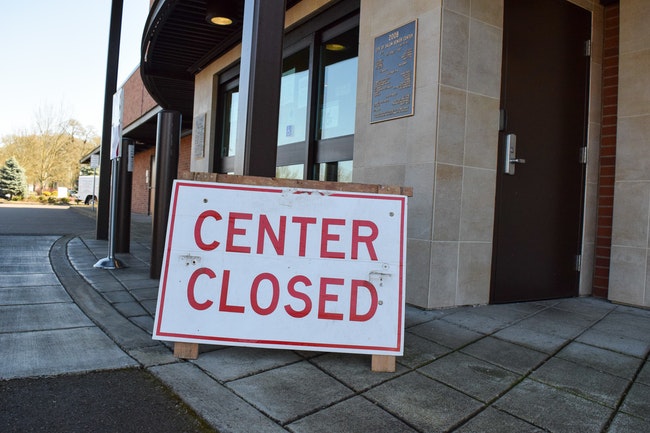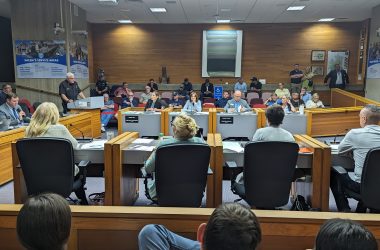 Center 50+, a city-run senior center, closed on Monday, March 16 . (Saphara Harrell/Salem Reporter)
Center 50+, a city-run senior center, closed on Monday, March 16 . (Saphara Harrell/Salem Reporter)
Marion County says it is ready to start lifting restrictions intended to slow the spread of COVID-19. But the county’s plan, released Wednesday, will face its first test when it’s sent to the governor’s office to determine if the area has met key measures needed to reopen.
The proposal by the Marion County Board of Commissioners comes as the county is experiencing the highest rate of the coronavirus infections in the state and lags behind other urban counties in testing.
Marion County hasn’t met many of the state’s requirements for reopening, including adequate testing, adequate contact tracers or a downward trajectory of cases over a 14-day period. But on Wednesday, materials were presented at the board meeting making the case that the county is making progress on key measures.
Commissioners want to begin opening restaurants, bars, child care, churches, retail businesses, theatres, health clubs and county parks on May 15, according to a three-phase roadmap released Wednesday afternoon.
DOCUMENT LINK: Marion County Roadmap
The Oregon Health Authority said testing will be a cornerstone of plans to reopen.
On May 1, Brown said the earliest any section of Oregon could open would be May 15 – and then only in rural counties with few coronavirus cases. As of May 6, Marion County has had 592 people test positive for the coronavirus, the second highest in the state behind Multnomah County, which has 793 cases.
Brown’s office is requiring a downward trajectory of both symptoms and documented cases within a 14-day period.
As of Wednesday, May 6, the county had 18 cases, 11 more than it did on April 22.
The county document said there’s been a decline in cases from a peak two and a half weeks ago.
Fifty-four county residents tested positive back between Saturday, April 18, and Monday, April 20, the largest three-day increase since the first Marion County resident confirmed positive on March 8.
The Health Authority this week released case numbers by ZIP code, showing the Gervais and Woodburn areas were leading the state in the number of cases per capita.
Two weeks ago, Katrina Rothenberger, director of the Marion County Public Health Department, said the numbers concerned her that the county was headed in the wrong direction.
On Wednesday, Rothenberger declined an interview through a county spokeswoman.
In the last week, 26 residents or employees tested positive at south Salem nursing home, Salem Transitional Care. Three have died.
To accomplish testing benchmarks, the county would need to increase its testing from 80 people per day to about 150. Since the start of last week, labs have returned tests for 132 Marion County residents per day to the Oregon Health Authority, on average.
One of the state’s requirements asks counties to have 15 contact tracers per 100,000 people. Marion County currently has 22 contact tracers and would need to more than double that number to meet guidelines.
The county’s roadmap document states that Marion County is rapidly ramping up its contact tracers, who investigate where the virus may have spread from confirmed patients.
“Our contact tracing capabilities have increased from 2.5 staff to the current 22 and are in the process of hiring additional staff, bringing on volunteers, and exploring a contract with Oregon State University for additional capacity to achieve our target for contact tracers. We have requested assistance from the Oregon Health Authority to train new contact tracers,” the roadmap reads.
Marion County’s board of commissioners is one of the few remaining government bodies meeting in person. At Wednesday’s meeting, Commissioner Kevin Cameron was the only one wearing a mask.
Another state prerequisite for opening would see hospitals able to accommodate a 20% increase in hospitalizations.
On April 23, Salem Health Chief Medical Officer Ralph Yates and CEO Cheryl Wolf sent a letter to the commissioners detailing the hospital’s surge capacity and lending support to reopening the county. According to the letter, Salem Health increased its bed capacity to 534 beds to accommodate for a previously anticipated surge.
Yates and Wolf wrote that Salem Health had seen a marked decline in COVID-19 patients from April 6 when there were 27 patients to April 23, when there were 15.
“Salem Health has more than adequate capacity to accommodate both an increase in volume and a surge of COVID-19 patients,” said the letter.
Yates and Wolf also wrote Salem Health has successfully established a reliable supply chain for masks and other protective gear, another requirement for easing restrictions.
Santiam Hospital and Legacy Health sent similar letters to the commissioners detailing their bed capacity and protective gear supply.
A testing plan from Brown’s office released earlier this week said counties in the mid-Willamette Valley are now testing about 18.8 people per 10,000 residents weekly. To reopen, those numbers need to reach 30 tests per 10,000, about 150 tests per day in Marion County.
Private providers offering tests in the county include Salem Health, Salem Clinic, Kaiser Permanente, Legacy Health and Yakima Valley Farmworker’s Clinic. Most began testing in mid or late March.
Providers and spokespeople with those clinics interviewed over the past week said securing swabs, protective equipment and other supplies needed to test patients was often difficult when they began but hasn’t limited testing in recent weeks.
“It’s gotten better and it hasn’t been an access issue for us,” said Nick Kashey, a family medicine doctor with Legacy Health who helped set up a testing site in Woodburn.
Most told Salem Reporter they’re testing 20 to 40 patients daily in Marion County.
Larger providers like Kaiser and Legacy are testing samples in their own labs in the Portland area. Others, including Salem Health, are contracting with private labs.
Correction: Marion County would need to test about 150 people per day to reach guidelines. This article previously misstated that.
Have a tip? Contact reporter Saphara Harrell at 503-549-6250, [email protected] or @daisysaphara.









